While working with farmers in Pali district I came across a local land race of wheat which is popularly known as kharchia wheat in the entire district. It is a very interesting to know as to how this variety get this name. Actually the origin of this wheat is from Kharchi village and the village was named kharchi due to high salt content in the soil and water available here.In local dilalect kharch means salt. Kharchia wheat is universally recognized as highly salt tolerant wheat genotype. This local land race is extensively used for the development of high yielding saline resistant variety namely Kharchia 65, KRL 1-4, KRL 39 and KRL 19. The metabolism and uptake of mineral get affected due to high concentration of salt in the soil. However, Kharchia can withstand the effects of salinity more efficiently. This is being used as the base material for the development of salt tolerant wheat variety not only in India but in other countries as well. Considering its potential value for future Crop Improvement programme, it has been registered in the NBPGR, New Delhi by the Directorate of Wheat Research, Karnal vide registration number INGR 99020. The Kharchia wheat is grown in kharchi village for a number of generations. The main region of growing this cultivar is high tolerance of salinity. Very low irrigation is required for kharchia wheat than other hybrid wheat varieties and at places where water is not available. It is also grown as rain fed on conserved soil moisture. Another feature of this variety is the plants are tall with more straw content so that the farmer gets more fodder along with grains for feeding to animals. The animals like the straw of kharchia wheat more than other wheat straw.
USES OF KHARCHIA WHEAT :
- It is primarily used for making chapatis. Taste of chapati is sweet and stays fresh for longer time.
- It is also used for making Dalia. Dalia is very tasty and fed to pregnant lady before and after delivery for better health care of mother.
- In storage no insect- pests are attracted on grains, hence it can be stored for long duration.
- It has high water use efficiency hence Dalia prepared from kharchia is very tasty and nutritive.
- It is also used for making ladoos by mixing sugar or jaggery with dry fruits which are used for feeding pregnant women.
- Used for making bati and churma (famous Rajasthani dishes).
Realizing the importance of this local land race we documented and applied for the PPV&FR Authority, New Delhi Plant Genome Saviour Community (PGSC) Award for kharchi village community . These awards are conferred every year to group of farmers and particularly the tribal and rural communities engaged in conservation, improvement and preservation of genetic resources of economic plants and their wild relatives particularly in the areas identified as agro bio-diversity hot-spots. The Authority constituted six teams for on-spot verification of the activities of the applicants finalized for Plant Genome Savior Community (PGSC) Awards, 2012-13. Finally the community of farmers, Kharchi village got this prestigious award which consist of a cash of Rs. 10 lakh, a citation and a memento which are given away by Honorable Agriculture Minister in a special function convened by the Authority at NASC Complex, New Delhi.
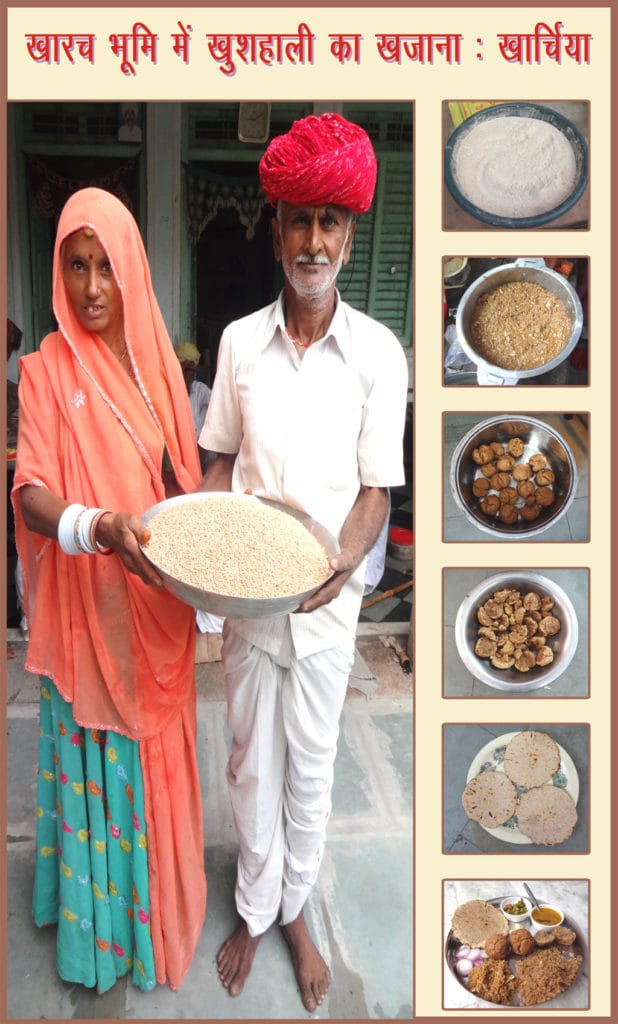
ABOUT KHARCI VILLAGE
LOCATION
Kharchi village is located 32 Km towards East from district headquarters Pali. It is a Gram Panchayat and has major contribution in the cultivation of Kharchia wheat. The total geographical area of this panchayat is about 12,224 sq km. Out of which 85 per cent of land area is used for agricultural practices with only four percent is irrigated area. Livestock is also one of the important sector allied with agriculture. The agro based industrial sectors of this district includes mainly henna industries, dal industries and milk processing plant.
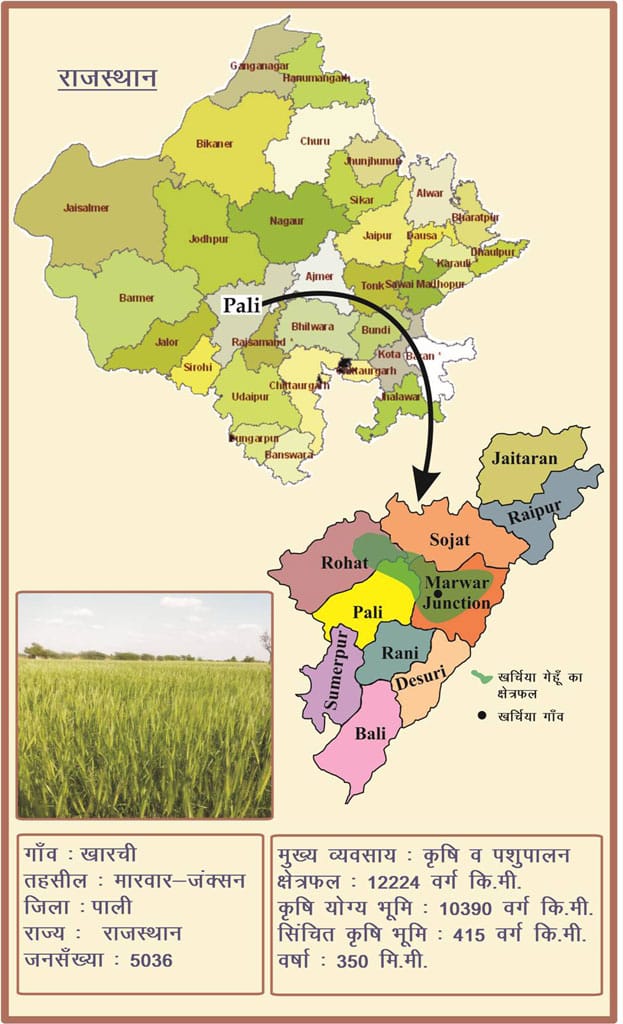
Kharchi has its own historical background during the time of Jog Maya Mandir. At that time, Kharchi village was the main business centre and marketing place for surrounding three villages and Panchayat Samiti Marwar Junction. This village and its surrounding land is so much affected by salt that it seems that someone had deposited a salt layer on the soil. Due to deposition of salt the land turns white from above and locally it is called as Kharach so by this character the village got the name Kharchi. Agriculture is the main occupation of the village people. Cluster bean, Moong, Til are grown in Kharif and Kharchia Wheat, Chickpea, Cumin, and Barley in Rabi is the major agricultural crops. Dairy sector is emerging in the village and currently the village is producing about 2500 litters milk per day and main animals like cattle, buffalo, sheep and goat. Ber, aonla and lahsora are the main horticultural crops of Kharchi village.
| CLIMATIC CONDITIONS | Arid to Semi-arid, 20-250 C |
| SOIL TYPE | Loam to sandy loam, salinity is predominant |
| SEED RATE | 100-120 kg/ha (depending on soil type). |
| METHOD OF SOWING | Under conserved moisture conditions Under irrigated condition: 4-5 irrigation |
| YIELD | 16-32 qt/ha. (Depending upon the quality of salinity of soil and water indicating the lowest and highest yield) |
| MAJOR PESTS | Termites |
| DISEASE | Yellow rust, Black smut |
QUALITY PARAMETERS OF KHARCHIA WHEAT:
| S.N. | CHARACTERISTICS | KHARCHIA WHEAT | NORMAL WHEAT |
| 1. | Grain Color | Red | Generally Amber |
| 2. | Grain Texture | Semi-Hard | Semi Hard To Hard |
| 3. | Chapati | 1.Soft (soft for eating and can be used for two days) 2. Chapati prepared in morning is used with butter milk in the after noon gives more taste | 1.Soft-semi-soft (can be used up to 4-5 hours on the same day only 2. Soft-semi-soft (can be used up to 4-5 hours on the same day only |
| 4. | Dalia | 1.Absorbs plenty of water for cooking and gives more quantity after cooking. 2. Gives more taste due to absorption of more water | 1.Absorbs less water 2.less tasty as compared to kharchia wheat |
| 5. | Bran | More bran | Less bran |
| 6. | Khichdi (Dalia+dal +ghee) | Given to the pregnant ladies, being light, there is less pressure on other body parts. It is light for stomach, increases blood and gives energy. | Normal |
| 7. | Salt affected water Yield | High production 16-32 qt/ha | Low production 10-15q/ha |
| 8. | Straw yield | More due to tallness | Less due to short height |
| 9. | Marketing approach | Used by local people migrants from this region prefer to purchase bulk stock for the entire year from illagers/growers directly. | Well established market channels. |

Since, the land of the village is mostly saline, therefore, Kharchia a local land race of wheat is cultivated in the village Kharchi and adjoining area in Pali District of Rajasthan. The Kharchi village is having 1200 bighas under kharchia wheat. The average yield of the Kharchia wheat is about 16-30 quintal per hactare. The yield potential is lower when cultivated in the saline soil and the yield increases, if the irrigation facilities are available and land is normal. The farmers only use Farm Yard Manure (FYM) in the fields. The Kharchia wheat is cultivated on conserved moisture mostly and without use of chemical fertilizers. Kharchia local is shared with surrounding villages and therefore it is cultivated in the neighborhood villages. The village is also visited by farmers of other places like Chennai, Pune, Bangalore, Hyderabad who visit them for purchase of Kharchia wheat for consumption and sowing purpose, who are well aware about its quality. Most of the villagers have confirmed the information about the Kharchia wheat landrace and its salient features. Out of interaction from the women folk, it was ascertained that the Kharchia wheat land race is very nutritive and healthy and the laddu and barfi are also made out of flour of Kharchia wheat by adding sugar and dry fruits. These laddu’s are given as a nutritive dish to the mother of the infants (newly born baby) a week or ten days after delivery. The dalia and lapsi are also commonly used in the houses for daily use in the breakfast. It was also informed by the women that the wheat flour absorbs high quantity of water in the kneading of dough and the keeping quality of chapatti remain fresh within 24 hours and never dries up like other wheat varieties.

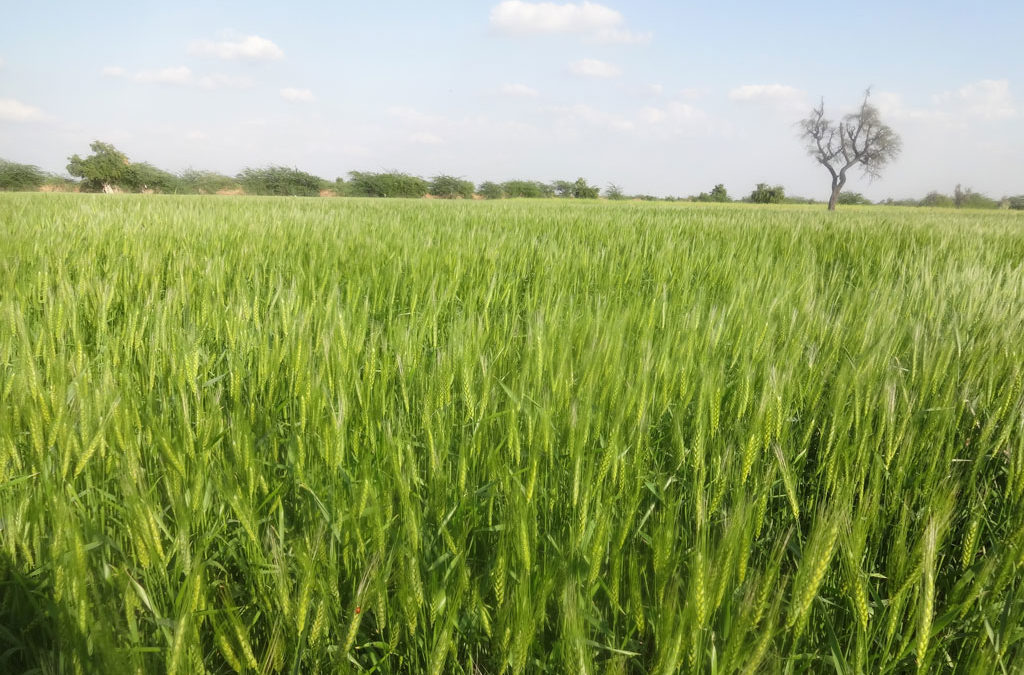





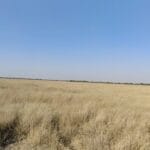


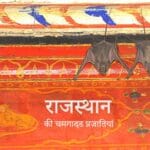

Very interesting to know the efforts for the development of rural India and its rural people! Jai Ho!
Really a very commendable work done by Dr Dheeraj Singh of KVK Pali.It is a boon for saline soil and saline water. This work should further be boosted.
It is very surprising to know about this wheat and its characteristics. Certainly Dr Dheeraj Singh has done a great work for farming community of his area.
Pleasure to have a introduction to amazing flora of Rajasthan.Dr Dheeraj Singh deserves compliments and lots of thanks for his efforts.
Hidden wealth of this prosperous thar desert. It is a pleasure reading such information which is so important yet so rare.my regard to author for revealing such facts.
Great great work and very nice compiled document.
Nice compiled work
A very new and innovative study by Dr Dheeraj Singh who brought forward this land race and benefitted the entire farming community.
Dr. Dheeraj Singh Ji, many thanks for sharing this knowledge, about Kharchiya wheat, on the internet.
This is really a noble piece of information and dr dheeraj singh desrves all the credit
My congratulation to Dr Dheeraj Singh for his efforts and bringing this landrace on portal.